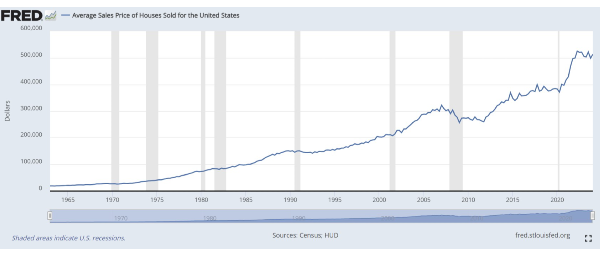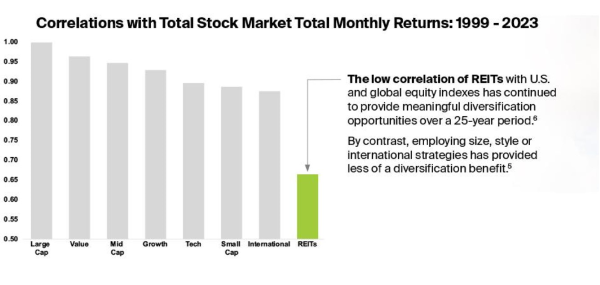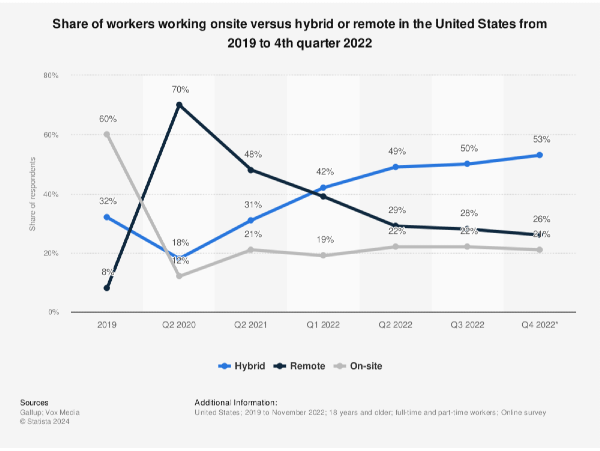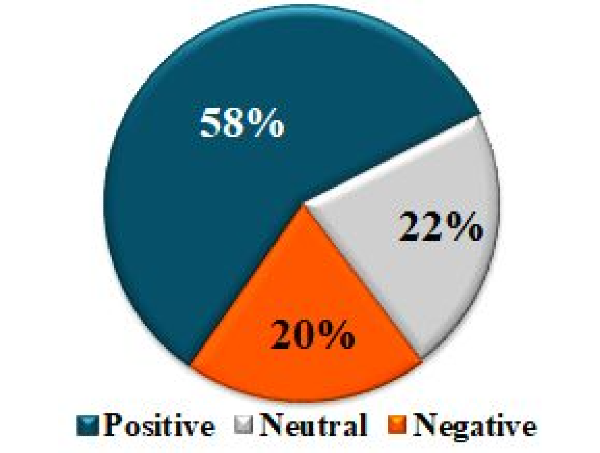Introduction
Investing in real estate has been one of the most successful investment strategies for building wealth in the last decades, maybe even in the last century. Traditional investments in real estate considers buying physical properties such as houses, apartments or even larger buildings for commercial or industrial purposes. While the latter two is more popular for large institutional investors, the goal of real estate investments remains the same, earn passive income from rent as well as asset appreciation. As we can see in Figure 1, the average sales price of houses sold in the US has been increasing substantially over time with the exception in 2008, during the financial crisis. Hence, real estate is a great investment opportunity but there is one major aspect to consider when investing in physical real estate. Namely, it requires sufficient capital with respect to down payments, property maintenance and management. Other risk factors that have to be taken into consideration are property location, vacancy rates, bad tenants etc.
**Figure 1: Average sales price of houses sold in the US **

Fortunately, in 1960, a new investment product has been introduced to the market by president Eisenhower. Real Estate Investment Trusts (REITs) were created and have revolutionized the way individuals can invest in large scale and diversified real estate portfolios. As a result, individual investors can now benefit from investing in real estate, without worrying about the capital requirements and other risk factors in this sector.
In this article we delve in to the world of REITs. Specifically, what is a, what makes a REIT unique, the pros and cons of investing in REITs, what metrics to focus on and finally some REITs stock to consider.
What is a REIT
A Real Estate Investment Trust (REIT) is a company that owns, operates or finances income-generating real estate. Investors can buy REITs by purchasing stocks in a public company, mutual funds or even invest in ETFs. As a result, stockholders are now eligible to earn a share of the income produced by the underlying real estate. Noteworthy is that most of the REITs are publicly traded in the stock market and therefore are highly liquid in comparison to physical real estate investments. Furthermore, there is a great variety of REITs and the respective investment they make in the real estate market. For example, some REITs are mainly focused on investing in residential housing while other have diversified real estate portfolios ranging from apartment buildings, offices, warehouses, medical facilities and much more.
What makes a REIT unique
Lets take a closer look on how REITs are able to pay such high dividends to their shareholders. In order for a company to qualify as a REIT, certain requirement have to be met. First, over 75% of the total assets needs to be invested in real estate. Next, 75% of the gross income has to be earned from rent, sale of real estate assets and interest payments on issued mortgages. Further, REITs are not required to pay income tax if they payout at least 90% of its taxable income as dividends to its shareholders. Finally other smaller requirements are, that it acts as a corporation, is managed by a board of directors, has 100+ shareholders and the shareholders have to be dispersed meaning that a few shareholders cannot hold 50% or more of the shares.
Furthermore, a distinction has to be made between the two main types of REITs. First, equity REITS are the most traditional ones as the REITs own properties in different real estate sectors and will rent out the buildings to other tenants and companies. The majority of the income they received has to be paid out to shareholders in the form of dividends. Hence, while it is attractive for investors to invest in REITs due to the dividends, do note that the value of the shares might fluctuate over time due to changing market conditions or cash flows issues of the company.
Next, mortgage REITs (mREITs) provide the financing for income producing real estate by purchasing or originating mortgages and mortgage-based-securities (MBS). In short, mREITs provide liquidity to the market and want to earn a profit or spread between the interest they earn on their mortgages and their funding costs which often represent the values of the mortgages issued to individuals and companies. This means that mREITs need a lot of money to issue mortgages. The most popular funding sources include raising capital by issuing equity as well as convertible and long term debt. Again, investors in mREITs are rewarded with the dividends that are being paid out but here there are more risks to consider as well. First interest risk, changing interest rates in the market can affect the spread and the net margin the REITs earn. This risk can be mitigated by buying interest rate swaps or sell assets during volatile interest rate periods in order to raise cash. Further, credit risk also needs to be taken into consideration with the risk of borrowers not being able to meet payment obligations. Hence, losing a part of their cashflow as a result.
Pros & Cons of REITs
REITs are very unique investment instruments and just as any other investment product, there are both pros and cons related to investing in REITs. Having a better idea of what investors can expect regarding their investments, can help them make more informed investment decisions that are aligned with their respective goals and risk tolerance.
Pros of investing in REITs
Starting off with the pros. Perhaps the biggest advantage of REITs is that individuals now have the opportunity to invest in real estate without any large capital requirement and neither the need to own and manage physical properties. This reduces the risk of entering the market significantly as you can enjoy the benefits of investing in real estate without taking into account all the external risk factors yourself. Next, because REITs have to pay out 90% of their income as dividends, the dividend yield of a REIT tends to be very high as well, usually around or even above 5%. Not only are investors rewarded with higher dividend payments, they can also earn a return if the share price increases thanks to the appreciation of the underlying assets owned by the company.
Furthermore, investing in REITs also adds diversification benefits to your portfolio. REITs tend to have a low correlation with the US and global equity market as can be seen in figure 2. As a result, the diversifiable risk within the investors portfolio can be reduced while maintaining competitive returns.
Figure 2: Correlation stock market and REITs

Additionally, REITs can further act as an effective inflation hedge. Meaning, when inflation is rising within a country, rent prices follow and will be increased in order to offset the increase in costs such as the increase in price of gas, electricity, maintenance costs etc. As a result, REITs now earn a larger cashflow which is beneficial to fight increasing costs or maintain their dividend payout ratio.
Finally, it is noteworthy to mention that REITs are publicly traded on exchanges and therefore are much more liquid in comparison to traditional real estate investments. Hence, investors can easily buy and sell the respective REITs. Investors further enjoy the benefit of a diversified real estate portfolio since REITs invest in properties across a variety of geographical locations. Therefore avoiding risks of bad location or occupancy rate risk.
Cons of REITs
So investing in REITs offers several advantages such as high dividends yields, diversification benefits, inflation hedge and high liquidity. However, there are also risks and cons to consider. First there is interest rate risk. When interest rates are rising, this could have a substantial effect on the cost of borrowing for REITs. Implying that costs increase and therefore the profitability of the company decreases, making it more difficult to pay out dividends which could in return harm the stock price. Another risk of rising interest rates is that this may reduce demand for REITs as investors switch to other investment instruments like government bonds which pay out a fixed interest rates with lower risk.
Another risk to consider is investing in the wrong REITs sector. Specifically, REITs that invest in the wrong type of real estate. One perfect example we have seen in the market is that REITs that are primarily invested in office buildings performed really bad. So what is the reason behind this? Ever since the Covid-19 pandemic in 2020, we have seen a huge boost in the people that started working remotely in their own homes. This argument can be found back in Figure 3 which depicts the percentage of the US workforce working either on-site, remote or hybrid. In 2020 we experienced a global lockdown due to Covid-19 and everyone was forced to work at home, 70% of workers worked remote during that time. What’s even more interesting to see is that after Covid, hybrid work kept on growing from 32% in 2019, to a whopping 53% at the end of Q4 2022. Fully remote worked experienced a surge as well, coming from 8% in 2019 to 26% at the end of 2022. Hence, the Covid-19 pandemic changed the working culture, from the majority working on-site to a more hybrid working lifestyle. To put this into perspective for office REITs, the demand of renting large offices decreased drastically and therefore, these REITs lost a lot of cashflow and revenue in the process, making it a bad investment. Hence, you should always take into account that the world is constantly changing and new trends arise.
Figure 3: On-site, remote and hybrid work

Other risk factors include the lack of control. Investors have no influence on the underlying real estate assets. Decision regarding property management, acquisitions and dispositions of real estate are made by the REITs board of directors. Hence, it is important to align your preferences with the respective REIT you are invested in. Finally, overall market risk and macro-economic risk should also be taken into account. During economic downturns, demand to real estate might decrease and therefore REITs experience fluctuations in the underlying property value and occupancy rates which could result in short term price swings in the stock.
Key metrics for REITs
When you are considering to invest in REITs, examining the income statement, balance sheet and cashflow statement is of major importance in order to determine the health and success of the REIT. With respect to the balance sheet, the total assets and debt to equity ratio are key metrics. If the total assets continue to grow over time, this could imply an increase in future income and asset appreciation. Further, the debt to equity ratio tells us something about the leverage of the REIT. Higher debt levels increase the financial risk of the company and vice versa.
When looking at the metrics of the income statement, revenue growth is very important as this indicates that the REIT is able to generate more income over time which potentially leads to higher dividend payments and an increase in the share price. Furthermore, the net operating profit reflects the efficiency of generating profits with the underlying real estate. Increasing profits over time suggests strong property performance.
Turning over to the cashflow statement, analyzing cashflows from operating activities helps assess the REIT's ability to generate cash from its core real estate activities. A strong positive cash flow is essential for dividend payments and reinvestment. Next, the capital expenditures looks at the investments the company makes in new real estate. Hence, it is important to determine whether the REIT has plenty of cash or cashflows to cover these large capital investments. Finally, the dividend payout ratio equals the dividends that are being paid out relative to the cashflows. You want to ensure that the ratio is strong, implying that the REIT can comfortably cover dividends without negatively affecting its financial health.
REITS stocks
Now that we know what REITs are, their pros and cons as well as the key metrics to look at, let’s mention a few REIT you could invest in:
- Realty Income (O): Realty Income primarily invests and leases freestanding commercial properties. They are further known for their consistent and reliable dividend payments, currently paying out a dividend rate of 5.6%
- Prologis (PLD): Prologis is the global leader in logistics real estate, their real estate portfolio includes warehouses and other industrial facilities. They are further committed to sustainability and enhancing buildings with the latest technologies such as solar panels. The current dividend yield is 3.5%
- American Tower Corporation (ATC): ATC focuses and operates in the wireless and broadcast communications infrastructure. The goal is to host multiple tenants on one tower, allowing them to reduce network infrastructure costs and provide excellent service to their customers. ATC provides a dividend yield of 3.2%
While I did mention a few of the more popular and larger cap REITs, it is always important to do your own due diligence and determine the financial health of the company. With the current market conditions in the US, Real estate companies are facing some risks since the cost of debt has increased and tenants could potentially miss their rent payments.
Conclusion
In summary, Real Estate Investment Trusts (REITs) provide investors with a great opportunity to access the real estate market without the hassles of property ownership and large capital requirements. Offering high dividend yields, diversification benefits, and liquidity, REITs have gained popularity among income-seeking investors. However, investors should remain cautious considering the risks such as interest rate fluctuations, sector-specific challenges, and market volatility.
Furthermore, thorough analysis of key metrics like revenue growth, total asset growth, and dividend payout ratios is essential to determine the financial health and potential of REITs. While established REITs like Realty Income, Prologis, and American Tower Corporation offer attractive prospects, investors must remain cautious due to evolving market conditions. By staying up to date with the latest market trends while implementing strong decision-making, REITs can serve as valuable components of a diversified investment portfolio, offering both income and growth potential over the long term.































Introduction
Investing in real estate has been one of the most successful investment strategies for building wealth in the last decades, maybe even in the last century. Traditional investments in real estate considers buying physical properties such as houses, apartments or even larger buildings for commercial or industrial purposes. While the latter two is more popular for large institutional investors, the goal of real estate investments remains the same, earn passive income from rent as well as asset appreciation. As we can see in Figure 1, the average sales price of houses sold in the US has been increasing substantially over time with the exception in 2008, during the financial crisis. Hence, real estate is a great investment opportunity but there is one major aspect to consider when investing in physical real estate. Namely, it requires sufficient capital with respect to down payments, property maintenance and management. Other risk factors that have to be taken into consideration are property location, vacancy rates, bad tenants etc.
**Figure 1: Average sales price of houses sold in the US **
Fortunately, in 1960, a new investment product has been introduced to the market by president Eisenhower. Real Estate Investment Trusts (REITs) were created and have revolutionized the way individuals can invest in large scale and diversified real estate portfolios. As a result, individual investors can now benefit from investing in real estate, without worrying about the capital requirements and other risk factors in this sector. In this article we delve in to the world of REITs. Specifically, what is a, what makes a REIT unique, the pros and cons of investing in REITs, what metrics to focus on and finally some REITs stock to consider.
What is a REIT
A Real Estate Investment Trust (REIT) is a company that owns, operates or finances income-generating real estate. Investors can buy REITs by purchasing stocks in a public company, mutual funds or even invest in ETFs. As a result, stockholders are now eligible to earn a share of the income produced by the underlying real estate. Noteworthy is that most of the REITs are publicly traded in the stock market and therefore are highly liquid in comparison to physical real estate investments. Furthermore, there is a great variety of REITs and the respective investment they make in the real estate market. For example, some REITs are mainly focused on investing in residential housing while other have diversified real estate portfolios ranging from apartment buildings, offices, warehouses, medical facilities and much more.
What makes a REIT unique
Lets take a closer look on how REITs are able to pay such high dividends to their shareholders. In order for a company to qualify as a REIT, certain requirement have to be met. First, over 75% of the total assets needs to be invested in real estate. Next, 75% of the gross income has to be earned from rent, sale of real estate assets and interest payments on issued mortgages. Further, REITs are not required to pay income tax if they payout at least 90% of its taxable income as dividends to its shareholders. Finally other smaller requirements are, that it acts as a corporation, is managed by a board of directors, has 100+ shareholders and the shareholders have to be dispersed meaning that a few shareholders cannot hold 50% or more of the shares.
Furthermore, a distinction has to be made between the two main types of REITs. First, equity REITS are the most traditional ones as the REITs own properties in different real estate sectors and will rent out the buildings to other tenants and companies. The majority of the income they received has to be paid out to shareholders in the form of dividends. Hence, while it is attractive for investors to invest in REITs due to the dividends, do note that the value of the shares might fluctuate over time due to changing market conditions or cash flows issues of the company.
Next, mortgage REITs (mREITs) provide the financing for income producing real estate by purchasing or originating mortgages and mortgage-based-securities (MBS). In short, mREITs provide liquidity to the market and want to earn a profit or spread between the interest they earn on their mortgages and their funding costs which often represent the values of the mortgages issued to individuals and companies. This means that mREITs need a lot of money to issue mortgages. The most popular funding sources include raising capital by issuing equity as well as convertible and long term debt. Again, investors in mREITs are rewarded with the dividends that are being paid out but here there are more risks to consider as well. First interest risk, changing interest rates in the market can affect the spread and the net margin the REITs earn. This risk can be mitigated by buying interest rate swaps or sell assets during volatile interest rate periods in order to raise cash. Further, credit risk also needs to be taken into consideration with the risk of borrowers not being able to meet payment obligations. Hence, losing a part of their cashflow as a result.
Pros & Cons of REITs
REITs are very unique investment instruments and just as any other investment product, there are both pros and cons related to investing in REITs. Having a better idea of what investors can expect regarding their investments, can help them make more informed investment decisions that are aligned with their respective goals and risk tolerance.
Pros of investing in REITs
Starting off with the pros. Perhaps the biggest advantage of REITs is that individuals now have the opportunity to invest in real estate without any large capital requirement and neither the need to own and manage physical properties. This reduces the risk of entering the market significantly as you can enjoy the benefits of investing in real estate without taking into account all the external risk factors yourself. Next, because REITs have to pay out 90% of their income as dividends, the dividend yield of a REIT tends to be very high as well, usually around or even above 5%. Not only are investors rewarded with higher dividend payments, they can also earn a return if the share price increases thanks to the appreciation of the underlying assets owned by the company.
Furthermore, investing in REITs also adds diversification benefits to your portfolio. REITs tend to have a low correlation with the US and global equity market as can be seen in figure 2. As a result, the diversifiable risk within the investors portfolio can be reduced while maintaining competitive returns.
Figure 2: Correlation stock market and REITs
Additionally, REITs can further act as an effective inflation hedge. Meaning, when inflation is rising within a country, rent prices follow and will be increased in order to offset the increase in costs such as the increase in price of gas, electricity, maintenance costs etc. As a result, REITs now earn a larger cashflow which is beneficial to fight increasing costs or maintain their dividend payout ratio.
Finally, it is noteworthy to mention that REITs are publicly traded on exchanges and therefore are much more liquid in comparison to traditional real estate investments. Hence, investors can easily buy and sell the respective REITs. Investors further enjoy the benefit of a diversified real estate portfolio since REITs invest in properties across a variety of geographical locations. Therefore avoiding risks of bad location or occupancy rate risk.
Cons of REITs
So investing in REITs offers several advantages such as high dividends yields, diversification benefits, inflation hedge and high liquidity. However, there are also risks and cons to consider. First there is interest rate risk. When interest rates are rising, this could have a substantial effect on the cost of borrowing for REITs. Implying that costs increase and therefore the profitability of the company decreases, making it more difficult to pay out dividends which could in return harm the stock price. Another risk of rising interest rates is that this may reduce demand for REITs as investors switch to other investment instruments like government bonds which pay out a fixed interest rates with lower risk.
Another risk to consider is investing in the wrong REITs sector. Specifically, REITs that invest in the wrong type of real estate. One perfect example we have seen in the market is that REITs that are primarily invested in office buildings performed really bad. So what is the reason behind this? Ever since the Covid-19 pandemic in 2020, we have seen a huge boost in the people that started working remotely in their own homes. This argument can be found back in Figure 3 which depicts the percentage of the US workforce working either on-site, remote or hybrid. In 2020 we experienced a global lockdown due to Covid-19 and everyone was forced to work at home, 70% of workers worked remote during that time. What’s even more interesting to see is that after Covid, hybrid work kept on growing from 32% in 2019, to a whopping 53% at the end of Q4 2022. Fully remote worked experienced a surge as well, coming from 8% in 2019 to 26% at the end of 2022. Hence, the Covid-19 pandemic changed the working culture, from the majority working on-site to a more hybrid working lifestyle. To put this into perspective for office REITs, the demand of renting large offices decreased drastically and therefore, these REITs lost a lot of cashflow and revenue in the process, making it a bad investment. Hence, you should always take into account that the world is constantly changing and new trends arise.
Figure 3: On-site, remote and hybrid work
Other risk factors include the lack of control. Investors have no influence on the underlying real estate assets. Decision regarding property management, acquisitions and dispositions of real estate are made by the REITs board of directors. Hence, it is important to align your preferences with the respective REIT you are invested in. Finally, overall market risk and macro-economic risk should also be taken into account. During economic downturns, demand to real estate might decrease and therefore REITs experience fluctuations in the underlying property value and occupancy rates which could result in short term price swings in the stock.
Key metrics for REITs
When you are considering to invest in REITs, examining the income statement, balance sheet and cashflow statement is of major importance in order to determine the health and success of the REIT. With respect to the balance sheet, the total assets and debt to equity ratio are key metrics. If the total assets continue to grow over time, this could imply an increase in future income and asset appreciation. Further, the debt to equity ratio tells us something about the leverage of the REIT. Higher debt levels increase the financial risk of the company and vice versa.
When looking at the metrics of the income statement, revenue growth is very important as this indicates that the REIT is able to generate more income over time which potentially leads to higher dividend payments and an increase in the share price. Furthermore, the net operating profit reflects the efficiency of generating profits with the underlying real estate. Increasing profits over time suggests strong property performance.
Turning over to the cashflow statement, analyzing cashflows from operating activities helps assess the REIT's ability to generate cash from its core real estate activities. A strong positive cash flow is essential for dividend payments and reinvestment. Next, the capital expenditures looks at the investments the company makes in new real estate. Hence, it is important to determine whether the REIT has plenty of cash or cashflows to cover these large capital investments. Finally, the dividend payout ratio equals the dividends that are being paid out relative to the cashflows. You want to ensure that the ratio is strong, implying that the REIT can comfortably cover dividends without negatively affecting its financial health.
REITS stocks
Now that we know what REITs are, their pros and cons as well as the key metrics to look at, let’s mention a few REIT you could invest in:
While I did mention a few of the more popular and larger cap REITs, it is always important to do your own due diligence and determine the financial health of the company. With the current market conditions in the US, Real estate companies are facing some risks since the cost of debt has increased and tenants could potentially miss their rent payments.
Conclusion
In summary, Real Estate Investment Trusts (REITs) provide investors with a great opportunity to access the real estate market without the hassles of property ownership and large capital requirements. Offering high dividend yields, diversification benefits, and liquidity, REITs have gained popularity among income-seeking investors. However, investors should remain cautious considering the risks such as interest rate fluctuations, sector-specific challenges, and market volatility.
Furthermore, thorough analysis of key metrics like revenue growth, total asset growth, and dividend payout ratios is essential to determine the financial health and potential of REITs. While established REITs like Realty Income, Prologis, and American Tower Corporation offer attractive prospects, investors must remain cautious due to evolving market conditions. By staying up to date with the latest market trends while implementing strong decision-making, REITs can serve as valuable components of a diversified investment portfolio, offering both income and growth potential over the long term.